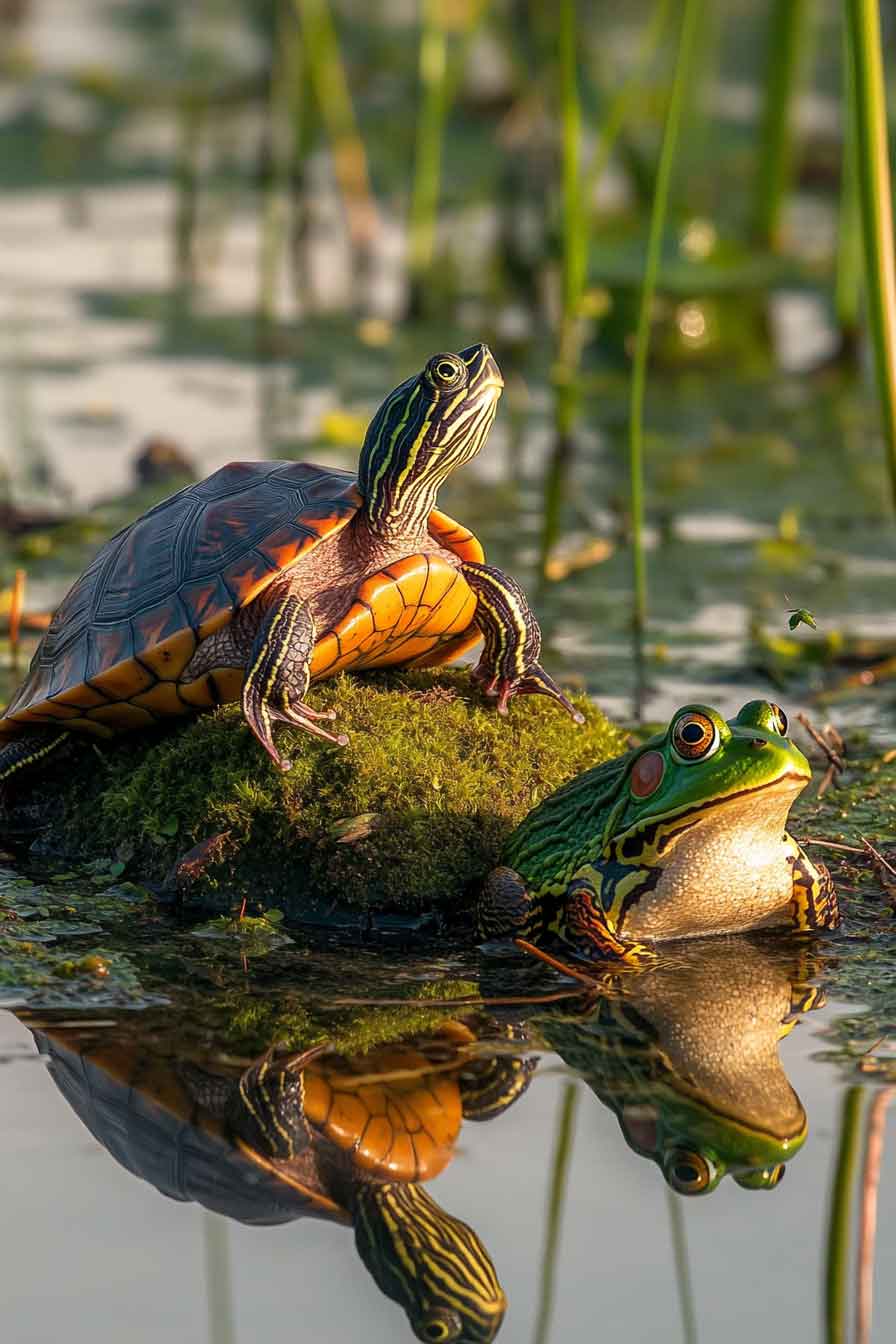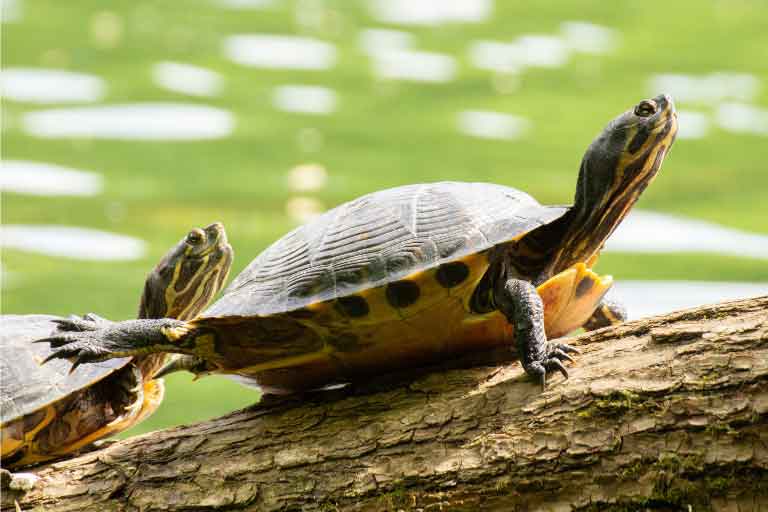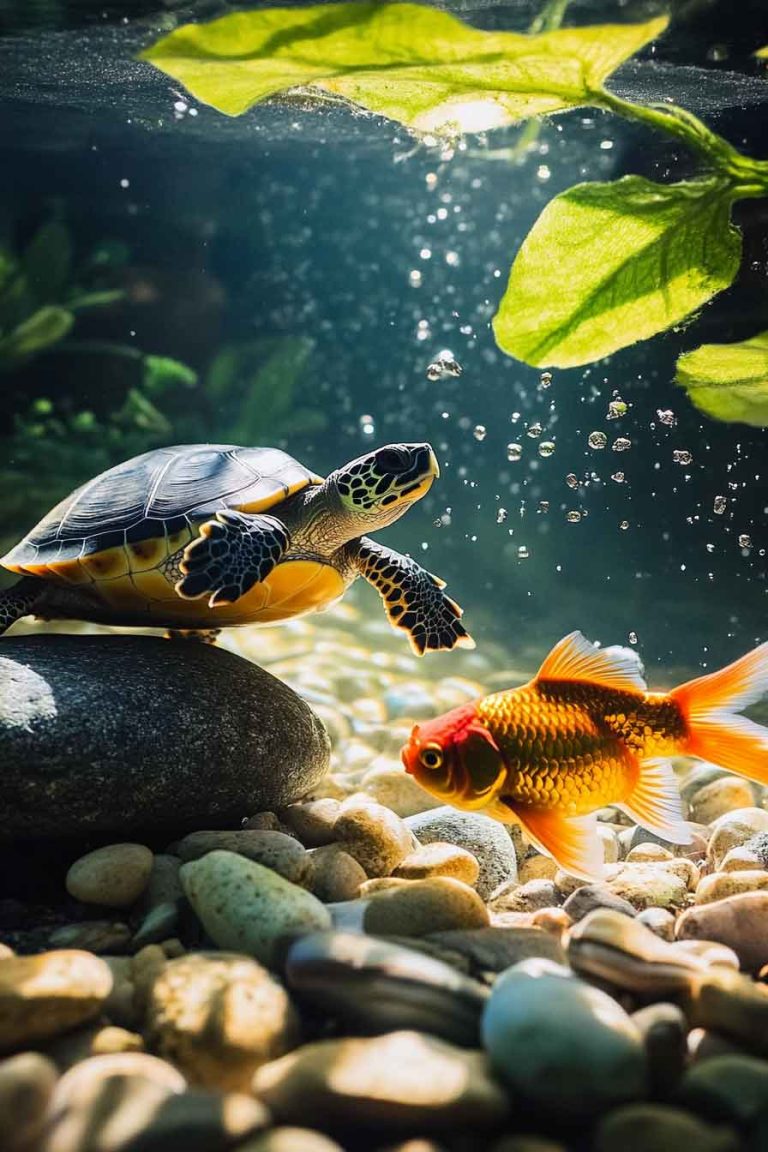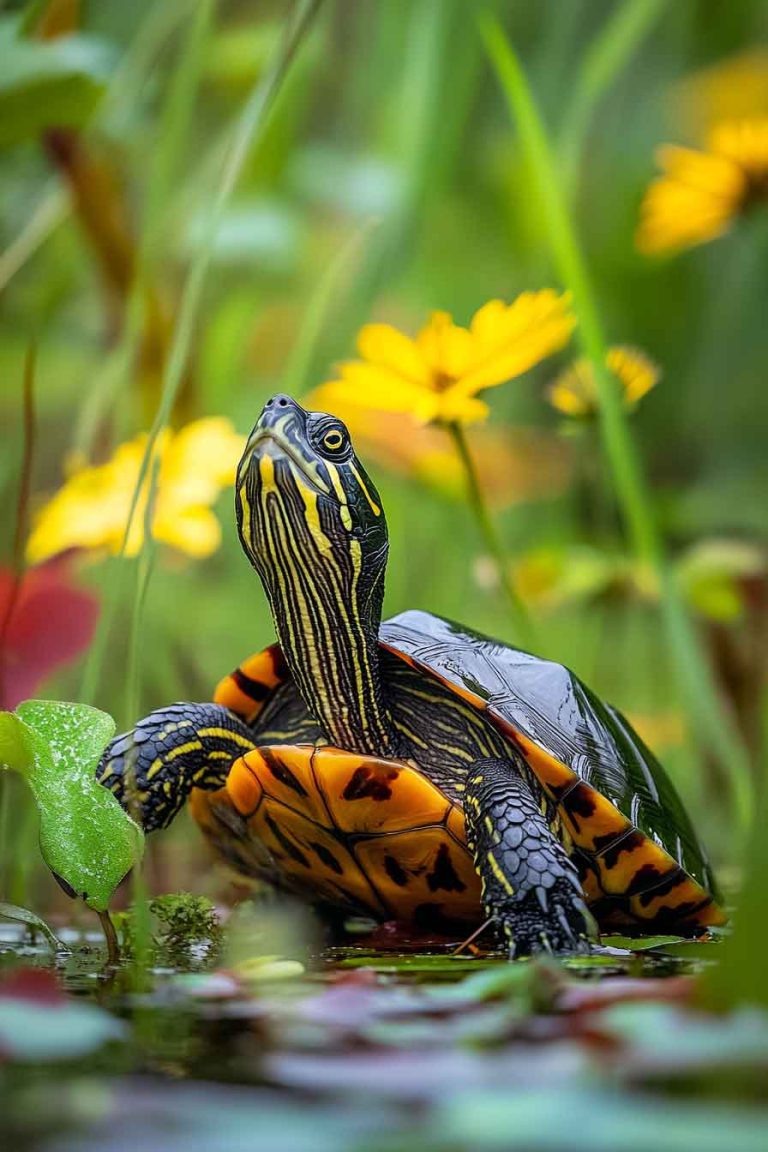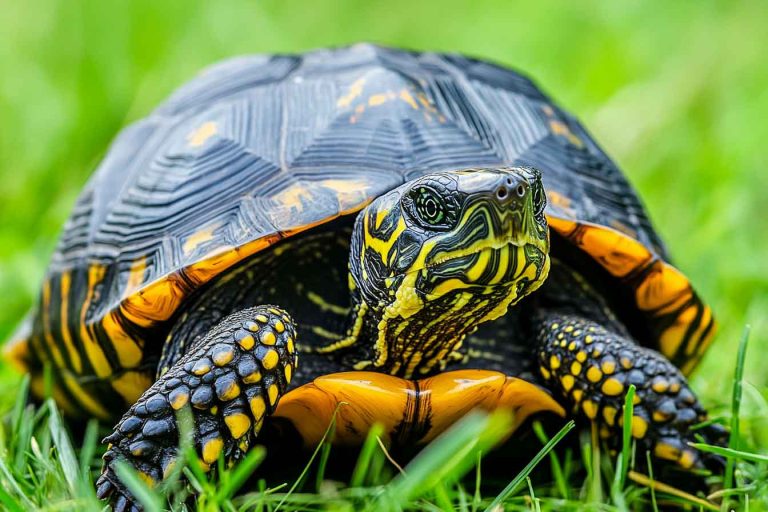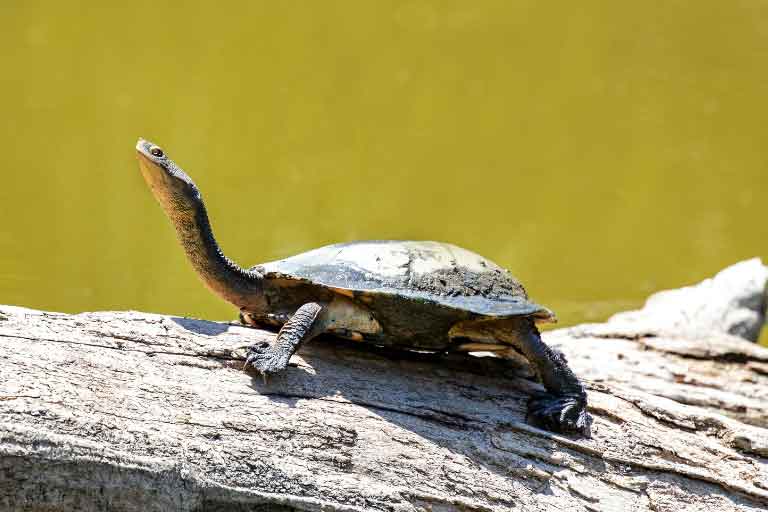Can Turtles and Frogs Live Together? What Are the Risks?
Have you ever looked at your turtle tank and thought, “Wouldn’t it be amazing to add a frog in here?” I know I have! The idea of watching these two fascinating creatures share the same space sounds wonderful, but before you rush to the pet store, I need to share some important information with you….
Have you ever looked at your turtle tank and thought, “Wouldn’t it be amazing to add a frog in here?” I know I have! The idea of watching these two fascinating creatures share the same space sounds wonderful, but before you rush to the pet store, I need to share some important information with you.
Today, I’m going to walk you through everything you need to know about keeping turtles and frogs together. Trust me, after years of working with reptiles and amphibians, I’ve learned that this combination isn’t as simple as it seems.
Can Turtles and Frogs Actually Live Together?
Here’s the truth: yes, turtles and frogs can technically live together, but only under very specific conditions. I want to be completely honest with you from the start—this setup is challenging and comes with serious risks that most pet owners aren’t prepared to handle.
The main issue? Both turtles and frogs are opportunistic feeders. What does this mean for you? Well, they’ll eat pretty much anything they can fit in their mouths, including each other. I’ve seen it happen, and it’s not something you want to experience with your beloved pets.
If you’re determined to try this, there’s really only one safe combination I can recommend: a box turtle paired with a green tree frog. Even then, you’ll need to create a very specific environment and monitor them constantly.
Understanding Your Pets’ Natural Behaviors
Before I dive into the specifics, let me help you understand why this pairing is so complicated. When I work with clients who want to house multiple species together, I always start by explaining their natural behaviors.
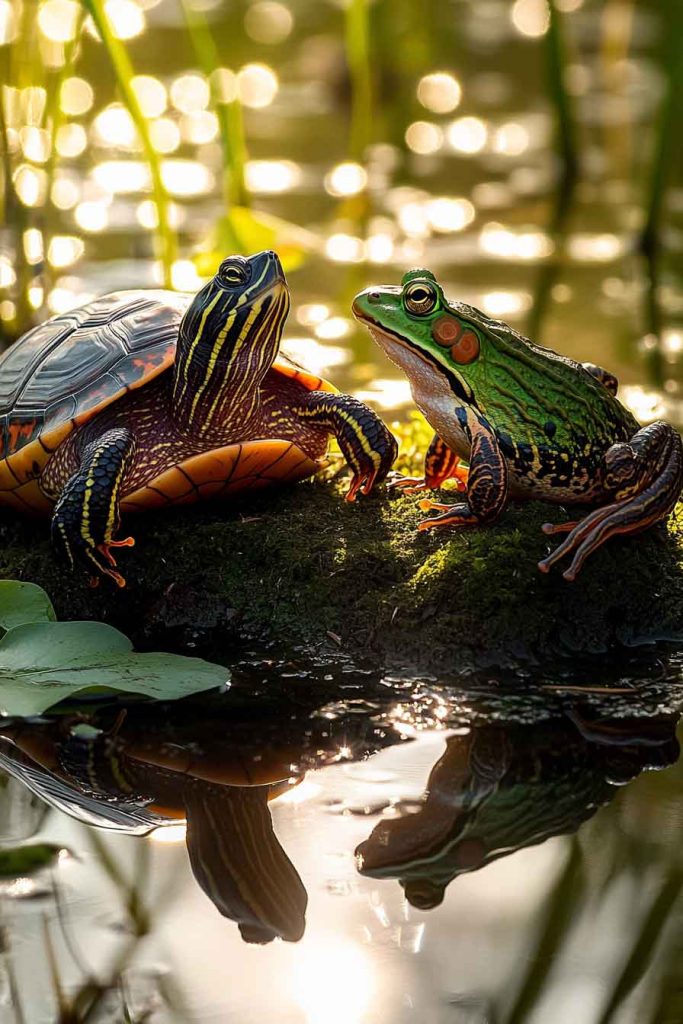
How Turtles Behave in Their Natural Habitat
Turtles, especially aquatic species, are fascinating creatures. I’ve spent countless hours observing them, and here’s what you need to know:
They spend most of their day doing two things: swimming and basking. When they’re not doing these activities, they’re hunting. And guess what’s on their menu? Small fish, insects, worms, and yes—frogs.
Here’s something crucial I want you to understand: turtles are solitary animals. They don’t seek companionship like dogs or cats do. In fact, they prefer living alone and often become stressed when forced to share their space. I’ve seen turtles become aggressive and withdrawn when tankmates are introduced.
Aquatic turtles are also incredible swimmers. They’re fast, agile, and extremely efficient hunters in water. If you place a frog in their tank, your turtle will likely view it as prey, not a friend.
How Frogs Behave in the Wild
Frogs have a completely different lifestyle, and understanding this will help you see why mixing them with turtles is problematic.
During the day, frogs are masters of disguise. They hide from predators, staying motionless and camouflaged. But when dusk arrives, they become active hunters, going after insects, snails, and small invertebrates.
Like turtles, frogs are also solitary creatures. They only come together briefly during spring for mating, then they go their separate ways. This means your frog won’t appreciate having a turtle roommate any more than your turtle wants a frog companion.
Here’s another important point: frogs are opportunistic feeders too. If your frog is larger than your turtle (especially if you have a baby turtle), the frog won’t hesitate to make a meal out of it.
The Reality Check: Why This Pairing Is Problematic
I need to be straight with you. After working with these animals for years, I can tell you that housing turtles and frogs together creates more problems than it solves.
Both animals will be under constant stress. Imagine living in a house with someone who might eat you at any moment. That’s essentially what you’re asking your pets to endure. This stress leads to depression, weakened immune systems, and shortened lifespans.
Every time I’ve consulted with someone trying to maintain this setup, they’ve reported the same issues: increased aggression, refusal to eat, hiding constantly, and eventually, one pet disappearing (and I think you can guess where it went).
Is There a Safe Way to Keep Them Together?
I know some of you are thinking, “But I’ve heard success stories!” You’re right—it is possible, but only if you follow very strict guidelines. Let me walk you through what you’d need to do.
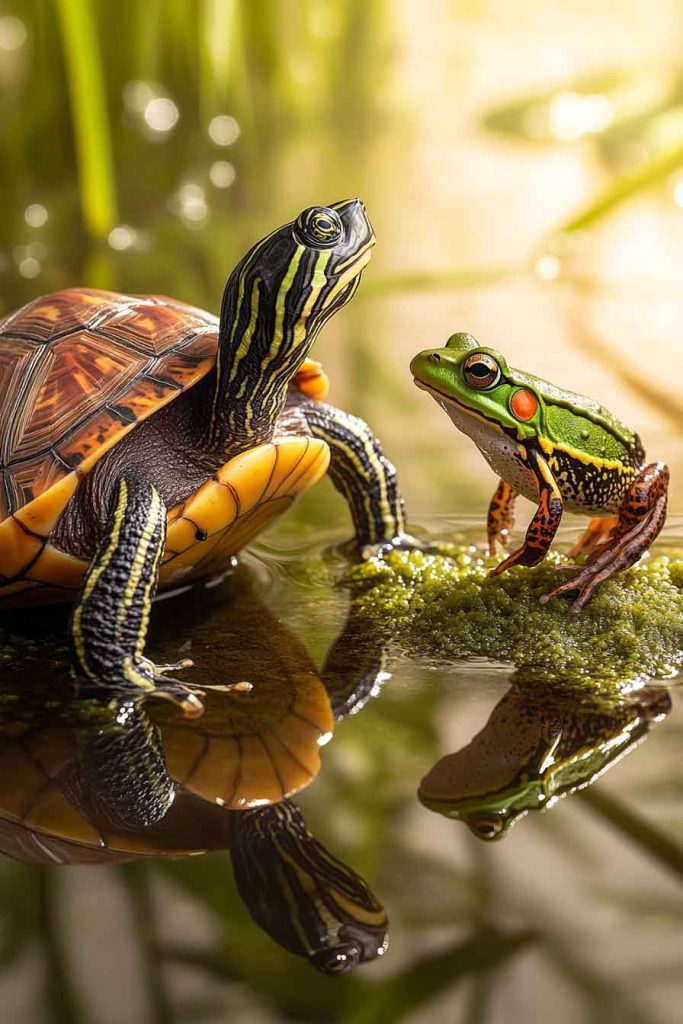
1. Choose the Right Species Combination
This is absolutely critical. You cannot just grab any turtle and any frog and hope for the best.
For turtles, I strongly recommend box turtles. Here’s why: Box turtles are primarily terrestrial (land-dwelling). They’re not strong swimmers, which means they’re less likely to chase down and catch your frog in the water. They’re also smaller and less aggressive than many aquatic species.
Whatever you do, avoid snapping turtles, alligator snapping turtles, or large aquatic species. These are efficient predators that will definitely eat your frog.
For frogs, green tree frogs or gray tree frogs are your best options. Here’s what makes them suitable:
- They produce minimal toxins (more on this later)
- They spend most of their time above water on branches and leaves
- They’re not large enough to threaten even a small box turtle
- They’re relatively peaceful and won’t provoke the turtle
I cannot stress this enough: avoid African bullfrogs, horned frogs, or any large aggressive species. These can grow to 6 inches or more and will absolutely attack small turtles.
2. Provide a Massive Tank
When I say massive, I mean it. You’re not going to make this work in a standard 20-gallon tank.
I recommend at minimum a 75-gallon tank, but honestly, bigger is always better. Here’s why size matters so much:
In a small tank, your pets are forced into constant contact. They can’t establish their own territories, they can’t avoid each other, and stress levels skyrocket. I’ve seen this lead to aggression, illness, and death.
In a larger tank, each animal can establish its own space. Your turtle can have a basking area and swimming zone, while your frog can have elevated perches and hiding spots. They can coexist without constantly confronting each other.
The tank also needs specific zones:
- Deep water area (at least 12 inches) for swimming
- Shallow water area for easy frog access
- Dry land area with a basking spot for the turtle
- Elevated branches and plants for the frog
- Multiple hiding spots for both animals
3. Consider the Toxin Factor
This is something many people don’t realize, and it’s incredibly important for your turtle’s health.
All frogs have parotoid glands that produce toxins. When threatened, they release these toxins as a defense mechanism. If your turtle tries to bite or eat the frog, it’ll get a mouthful of these toxins, causing:
- Burning sensation in the mouth and throat
- Excessive salivation
- Vomiting
- In severe cases, neurological problems or death
This is why choosing the right frog species is crucial. Green tree frogs and gray tree frogs produce relatively mild toxins that are less likely to seriously harm your turtle. However, poison dart frogs, tomato frogs, and many other colorful species are absolutely off-limits. Their toxins can kill your turtle.
I always tell my clients: if you wouldn’t handle a frog without washing your hands immediately after, don’t put it in a tank with your turtle.
4. Create Separate Feeding Stations
Competition for food is a huge problem when housing these animals together. Here’s what I’ve learned works best:
Feed your turtle in one area of the tank (or better yet, in a separate feeding container). Feed your frog in a completely different area, preferably on an elevated platform the turtle can’t reach.
Never toss food into the center of the tank and let them fight over it. Your turtle will almost certainly dominate, leaving your frog malnourished and stressed.
I also recommend feeding them at different times. Turtles are often most active during the day, while frogs are crepuscular (active at dawn and dusk). Use this to your advantage.
The Serious Risks You Need to Understand
I want to make sure you fully grasp what you’re getting into. Let me break down the major risks involved in this setup.
Risk 1: Death
I’m not trying to scare you, but this is the harsh reality. One of your pets could die, and it might happen quickly.
Scenarios where your frog could die:
- Your turtle successfully hunts and eats it
- Your turtle injures it during an attempted attack
- Stress from constant fear weakens its immune system
- It starves because the turtle dominates feeding time
Scenarios where your turtle could die:
- It ingests too many frog toxins
- A large frog attacks and injures it (especially if it’s a hatchling)
- Stress-related illness
- Water quality issues from having too many animals in one space
I’ve had clients call me in tears because they found half their frog floating in the tank or their baby turtle missing. It’s heartbreaking, and completely preventable by housing them separately.

Risk 2: Toxic Exposure
Even if your turtle never successfully eats your frog, repeated exposure to frog toxins is dangerous.
Every time your turtle investigates, bites, or stresses the frog, those parotoid glands are releasing toxins into the water. Your turtle is constantly swimming in this contaminated water, potentially absorbing toxins through its skin and ingesting them during feeding.
Chronic low-level toxin exposure can cause:
- Loss of appetite
- Lethargy
- Skin problems
- Kidney and liver damage over time
- Shortened lifespan
This is insidious because you might not notice immediate symptoms. Your turtle just gradually becomes less healthy.
Risk 3: Chronic Stress and Depression
This is perhaps the most overlooked risk, but it’s extremely serious.
Imagine you’re living in a house with someone who might attack you at any moment. You can never fully relax. You’re always on guard. Every sound makes you jump. This is what you’re creating for your pets.
Signs of chronic stress I’ve observed include:
- Refusing to eat or reduced appetite
- Hiding constantly
- Becoming aggressive or withdrawn
- Pacing or repetitive behaviors
- Weakened immune system leading to frequent illness
- Self-harm (like shell biting in turtles)
Stressed animals don’t just have a lower quality of life—they also die younger. You’re literally shortening their lifespans by forcing them to cohabitate.
Risk 4: Disease Transmission
Here’s something people rarely consider: reptiles and amphibians can transmit diseases to each other.
Frogs are particularly susceptible to ranavirus and chytrid fungus, both of which can be fatal. While turtles are less susceptible to these specific diseases, they can carry them on their shells and transmit them to your frog.
Conversely, turtles can carry bacteria and parasites that harm frogs. When you house them together, you’re creating the perfect environment for disease transmission.
Why I Generally Don’t Recommend This Setup
After everything I’ve shared, you might be wondering why anyone attempts this. The truth is, the appeal is purely aesthetic—we think it looks cool. But from a practical and ethical standpoint, it creates far more problems than benefits.
Let me break down the fundamental incompatibilities.
They Have Completely Different Environmental Needs
Turtles need:
- A basking area with temperatures of 85-95°F
- UVB lighting for shell and bone health
- Deep water for swimming (species-dependent)
- Relatively clean, filtered water
Frogs need:
- High humidity (often 60-80%)
- Cooler temperatures (usually 70-75°F)
- Shallow water or moist substrate (species-dependent)
- Live plants and hiding spots
See the problem? Creating an environment that truly meets both sets of needs is nearly impossible. Something always has to compromise, which means at least one of your pets isn’t living in optimal conditions.
I’ve seen tanks where the basking area is too hot for the frog, causing it to dehydrate. I’ve seen tanks kept so humid for the frog that the turtle develops shell rot. It’s a constant balancing act that usually ends with one or both animals suffering.
They Have Conflicting Behavioral Needs
Beyond physical environment, their behavioral needs clash fundamentally.
Turtles need:
- Solitary space
- A basking platform where they can fully dry off
- Feeling secure and unthreatened
- Established territory
Frogs need:
- Solitary space
- Vertical climbing areas
- Multiple hiding spots
- Feeling secure from predators (which includes your turtle)
In a shared tank, both animals feel their territory is being invaded. They’re constantly on edge. It’s like forcing two introverts to be roommates in a tiny apartment—neither is happy.
They’ll Compete for Resources
Even if you provide separate feeding stations, competition is inevitable.
Both turtles and frogs eat insects, worms, and small invertebrates. If you’re adding live food to the tank, they’ll both go after it. Turtles are generally faster and more aggressive feeders, which means your frog often loses out.
I’ve worked with clients where the turtle was becoming obese while the frog was slowly starving, all because the turtle dominated every feeding opportunity.
There’s also competition for prime hiding spots, basking areas (if the frog ventures onto land), and even water space. This constant competition adds yet another layer of stress.
The Long-Term Reality
Here’s what I’ve observed happens in most turtle-frog cohabitation attempts:
Month 1-2: Everything seems fine. Both animals are adjusting to the new environment. You think, “Great! This is working!”
Month 3-4: You start noticing issues. Maybe the frog is hiding more. Maybe the turtle is aggressive during feeding. You tell yourself it’s normal adjustment.
Month 5-6: Clear problems emerge. One animal isn’t eating well. There might be an injury. The water quality is harder to maintain. You’re constantly worried.
Month 6+: Either one animal has died/been injured, or you’ve separated them. You wish you’d never tried it in the first place.
I’ve had this conversation dozens of times. The pattern is remarkably consistent.
Better Alternatives for Tank Mates
I know you want to create a diverse, interesting tank. I get it—I do too! But let me suggest some better alternatives that won’t put your pets at risk.
Good Tank Mates for Turtles
If you want to add companions to your turtle tank, consider:
Fish: Fast-swimming fish like goldfish (for cooler water turtles) or certain cichlids can work. Yes, your turtle might eat some, but they’re less intelligent and don’t experience stress the same way. Plus, fish are inexpensive to replace.
Snails: Mystery snails, apple snails, or other large snails can coexist well. They help clean the tank, and most turtles won’t bother them. If they do eat one occasionally, snails breed readily.
Aquatic plants: Not exactly a “tank mate,” but live plants create visual interest, improve water quality, and provide enrichment for your turtle without any risk.
Another turtle of the same species: This can work if you have a very large tank and introduce them young. However, monitor carefully for aggression.
Good Tank Mates for Frogs
For your frog, better options include:
Other frogs of the same species: Many tree frogs do okay in small groups if the tank is large enough.
Small non-aggressive fish: Certain small fish species can coexist with frogs, though be aware the frog might eat very small fish.
Invertebrates: Isopods, springtails, and certain beetles can create a naturalistic cleanup crew without bothering your frog.
Live plants: Essential for frogs! They provide humidity, hiding spots, and climbing surfaces.
My Final Recommendations
After everything I’ve shared, here’s what I recommend:
If you already have a turtle and want a frog (or vice versa): Set up a second tank. Yes, it’s more space and more work, but it’s the only way to ensure both animals thrive. Place the tanks near each other if you want to watch both.
If you’re determined to try cohabitation: Use only the species combinations I’ve mentioned (box turtle and green tree frog), provide at minimum a 75-gallon tank, monitor constantly, and have a backup plan ready for when you need to separate them.
If you want diversity in your tank: Choose appropriate tank mates as I’ve outlined above rather than forcing incompatible species together.
If you prioritize your pets’ wellbeing: Keep them separate. I know it’s not the answer you wanted, but it’s the right one.
Frequently Asked Questions
Let me address some common questions I receive about this topic.
Can I keep baby turtles with frogs since they’re smaller?
No! This is actually more dangerous. Baby turtles are vulnerable to predation from larger frogs, and they haven’t developed the coordination to catch frogs successfully, leading to more stress. Additionally, baby turtles are more sensitive to frog toxins.
What if I breed them together from birth?
This doesn’t change their fundamental nature. A turtle raised with a frog will still view frogs as food once it reaches maturity. Their hunting instinct is innate, not learned.
My friend has turtles and frogs together with no problems. Why can’t I?
Your friend might be lucky, have the perfect species combination, or might not be aware of the chronic stress their pets are experiencing. Success stories exist, but they’re the exception, not the rule. And often, the “success” is measured in months or a few years, not the animal’s full potential lifespan.
What about separating the tank with a divider?
This can work if the divider is completely secure (no gaps), waterproof, and provides separate filtration for each side. Essentially, you’re creating two tanks within one, which defeats the purpose of cohabitation while still making maintenance more difficult.
Which turtles are most likely to eat frogs?
Snapping turtles, alligator snapping turtles, and most aquatic turtles (like red-eared sliders, painted turtles, map turtles) are active frog predators. Even smaller turtles will eat frogs if given the opportunity.
Are there any frogs that are safe for all turtle species?
No. The combination of right species, tank size, and setup is specific. There’s no “universally safe” frog for turtles.
Conclusion: Making the Right Choice for Your Pets
I know this article might have disappointed some of you. You came here hoping I’d tell you exactly how to create a harmonious turtle-frog paradise, and instead, I’ve spent most of this article explaining why it’s a bad idea.
But here’s the thing: I care more about your pets’ wellbeing than telling you what you want to hear.
Turtles and frogs are both incredible animals. They deserve environments where they can thrive, not just survive. They deserve to live without constant fear, stress, or competition. They deserve owners who prioritize their needs over aesthetic preferences.
If you truly love both turtles and frogs, the best thing you can do is give them separate homes where each can live according to their natural behaviors and needs. You’ll have two happy, healthy pets instead of two stressed animals in an uneasy truce.
I’ve kept both turtles and frogs for years, and I can tell you—watching a relaxed, content turtle basking without fear is far more rewarding than watching a stressed turtle constantly looking over its shoulder. Same goes for frogs.
Make the choice that’s best for them, not just convenient for you. Your future self (and your pets) will thank you.
If you have more questions about turtle care, frog care, or appropriate tank mates for either, feel free to reach out. I’m always happy to help fellow reptile and amphibian enthusiasts create the best possible homes for their pets.
Remember: just because something is possible doesn’t mean it’s advisable. In this case, keeping your turtle and frog separate is the kindest choice you can make.

